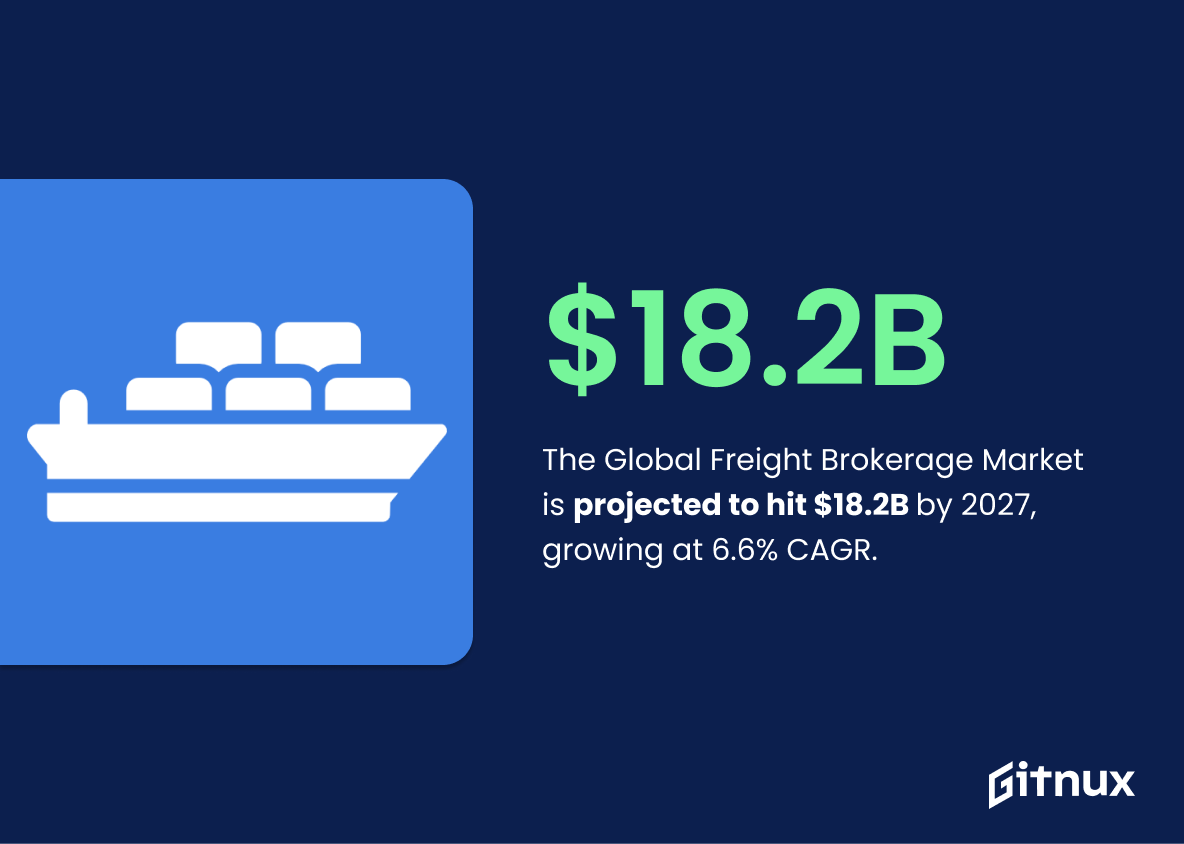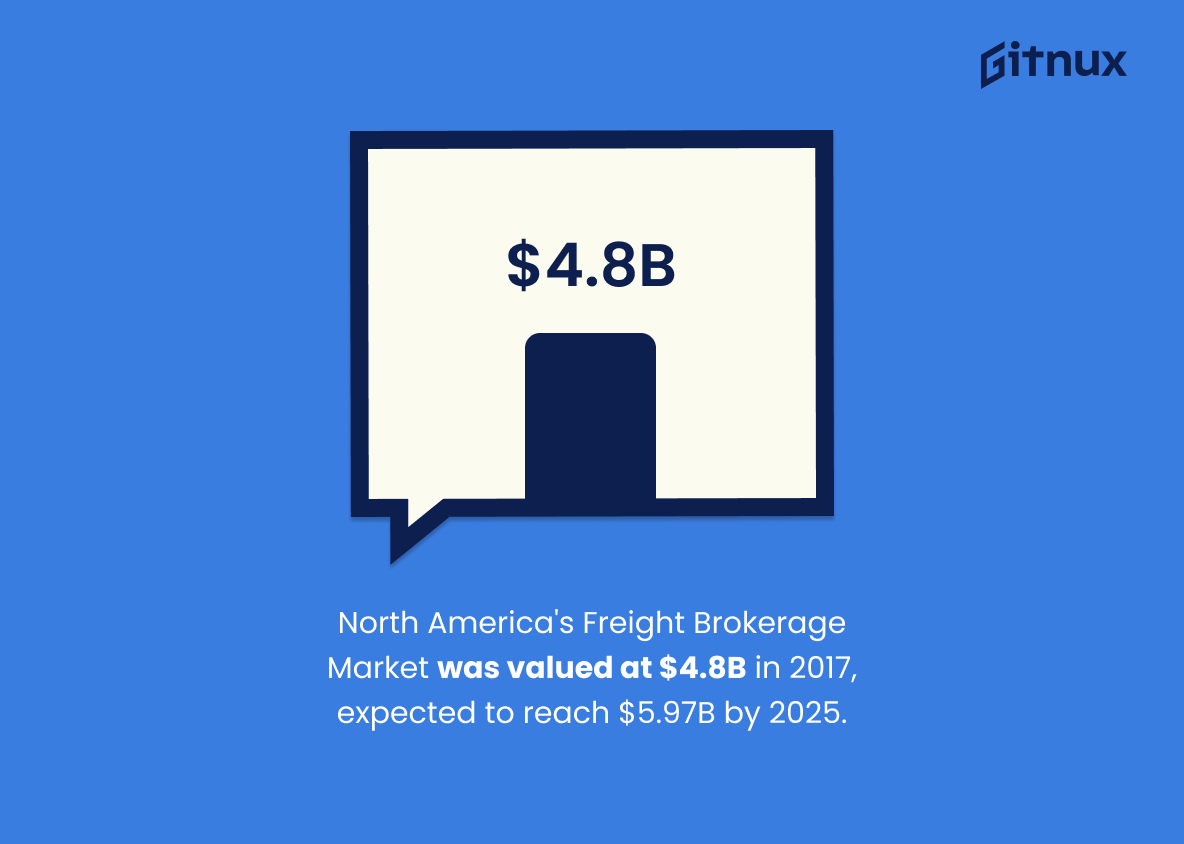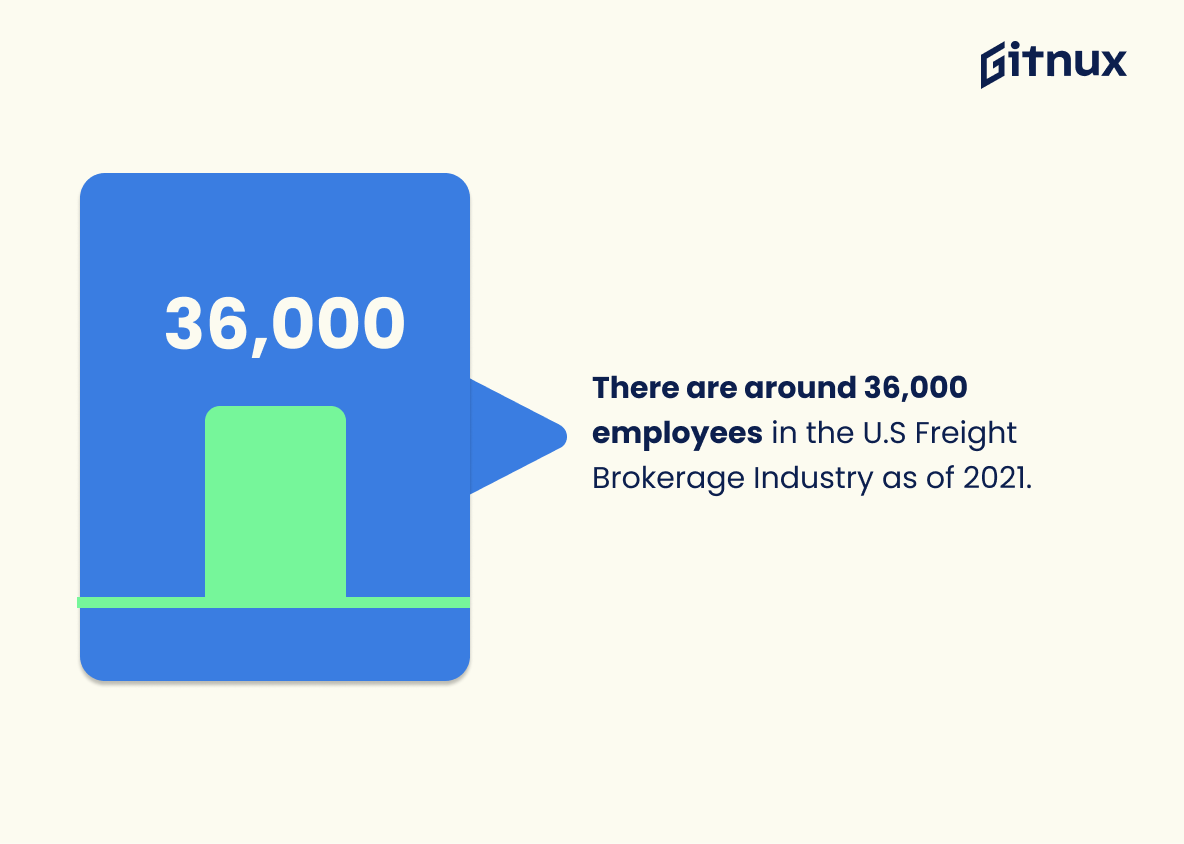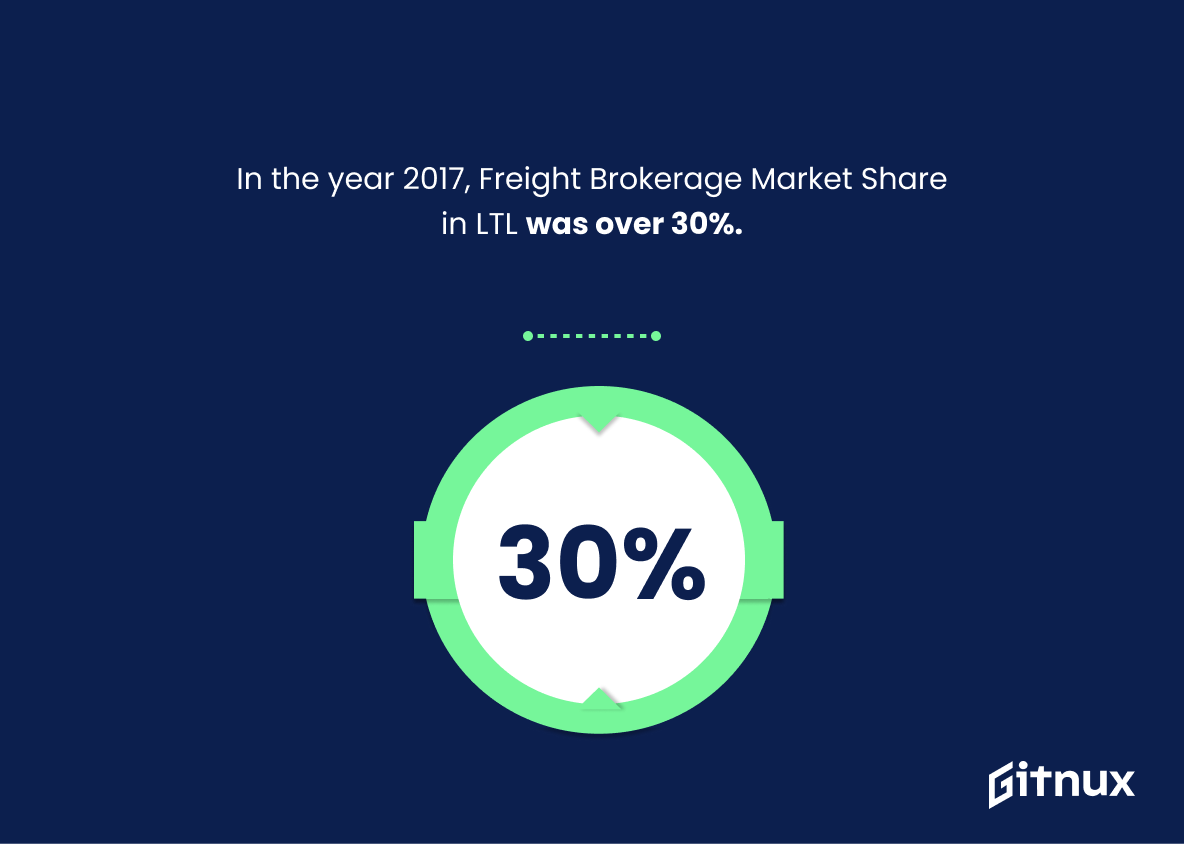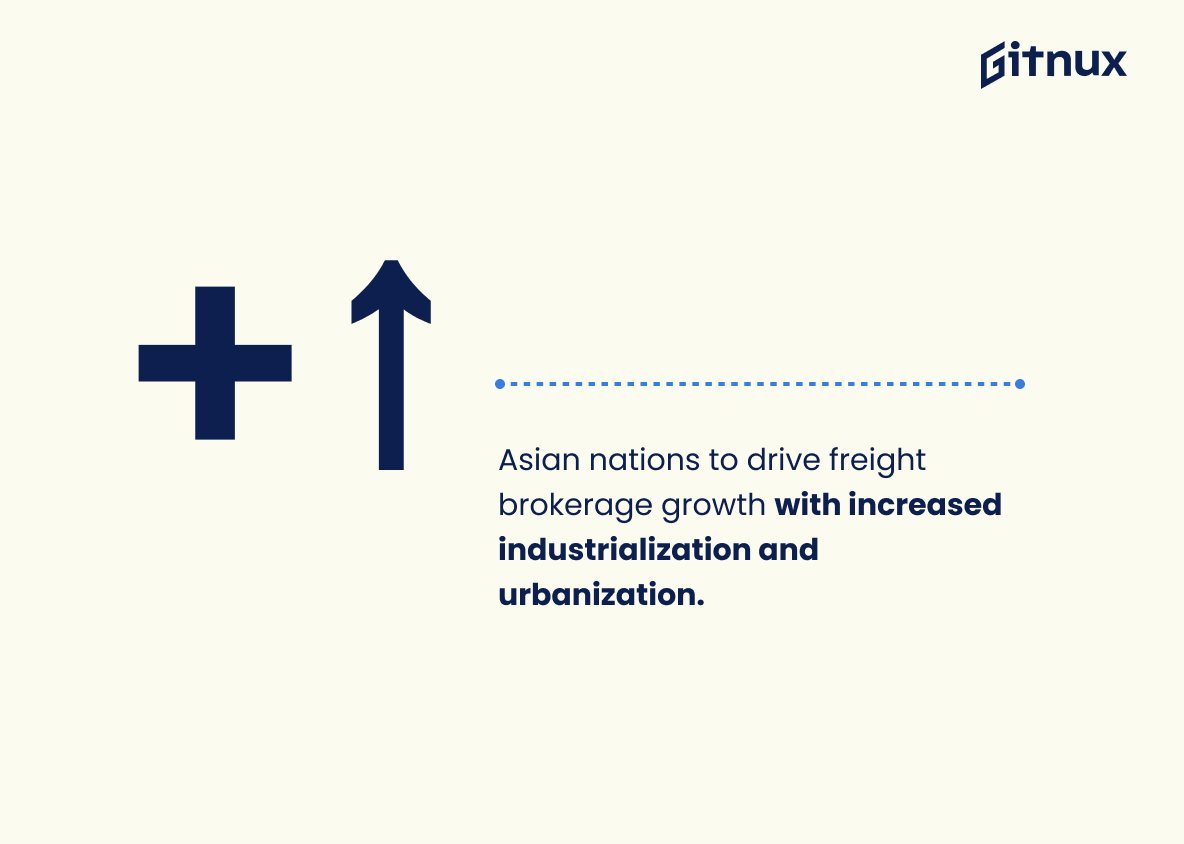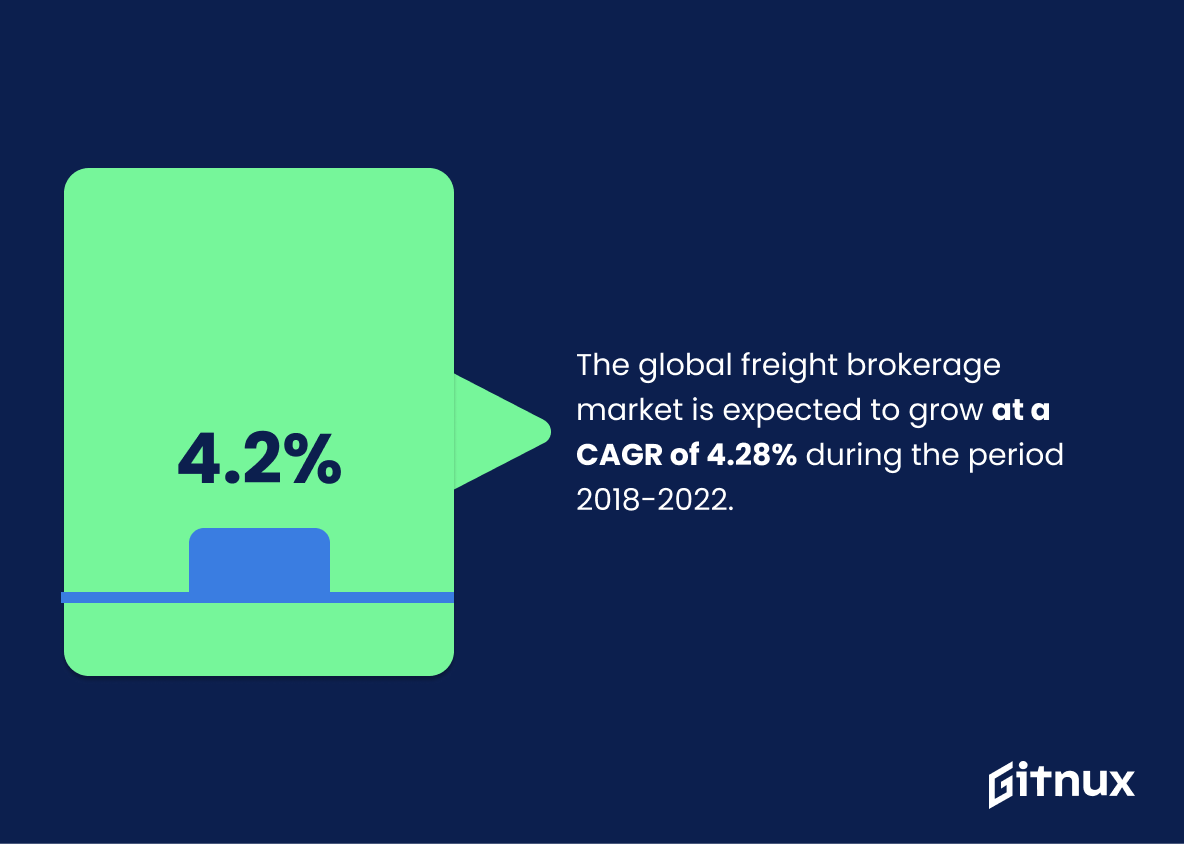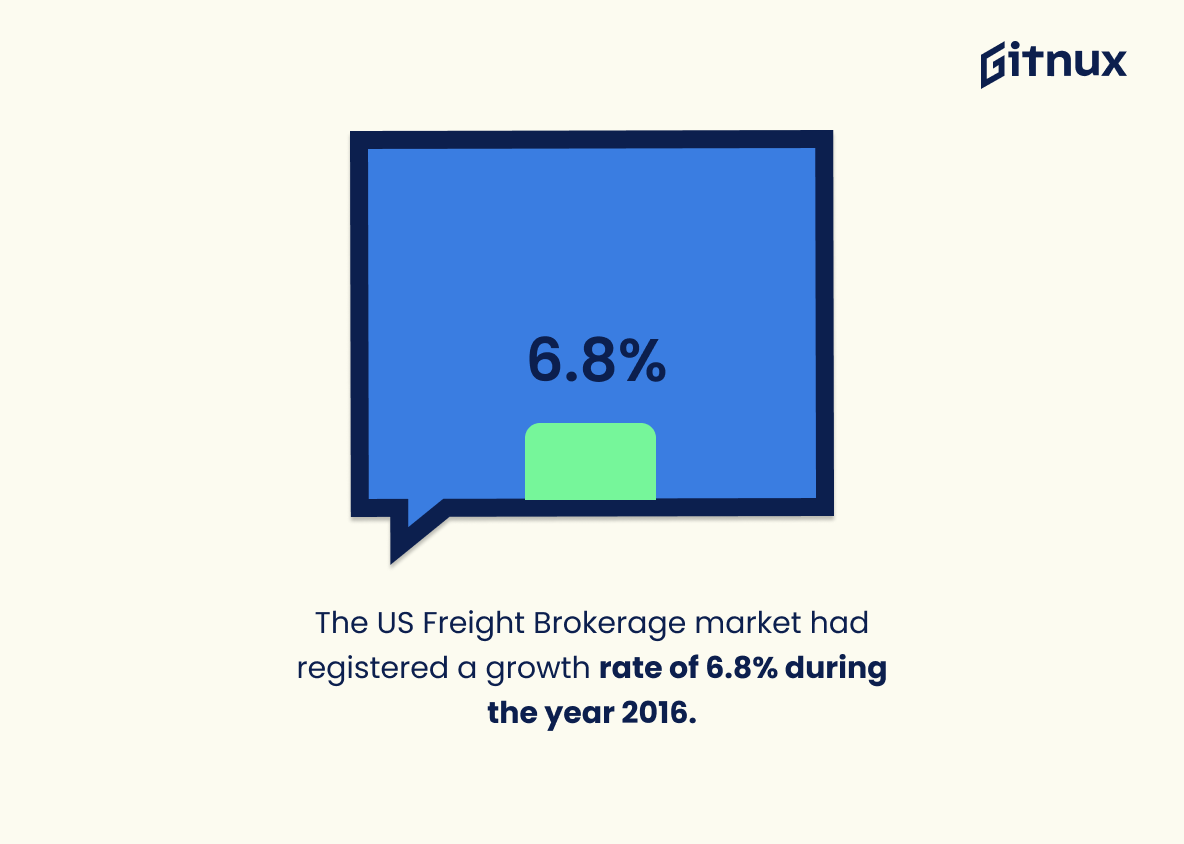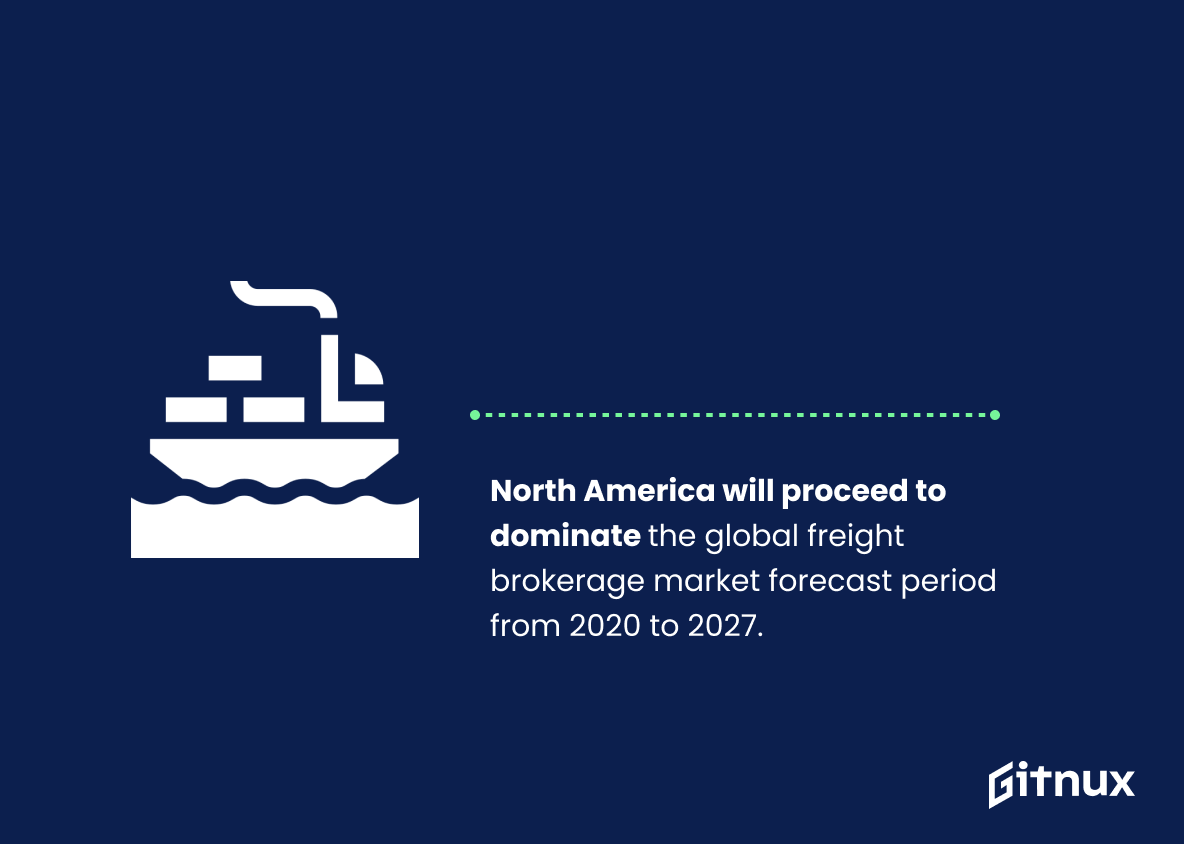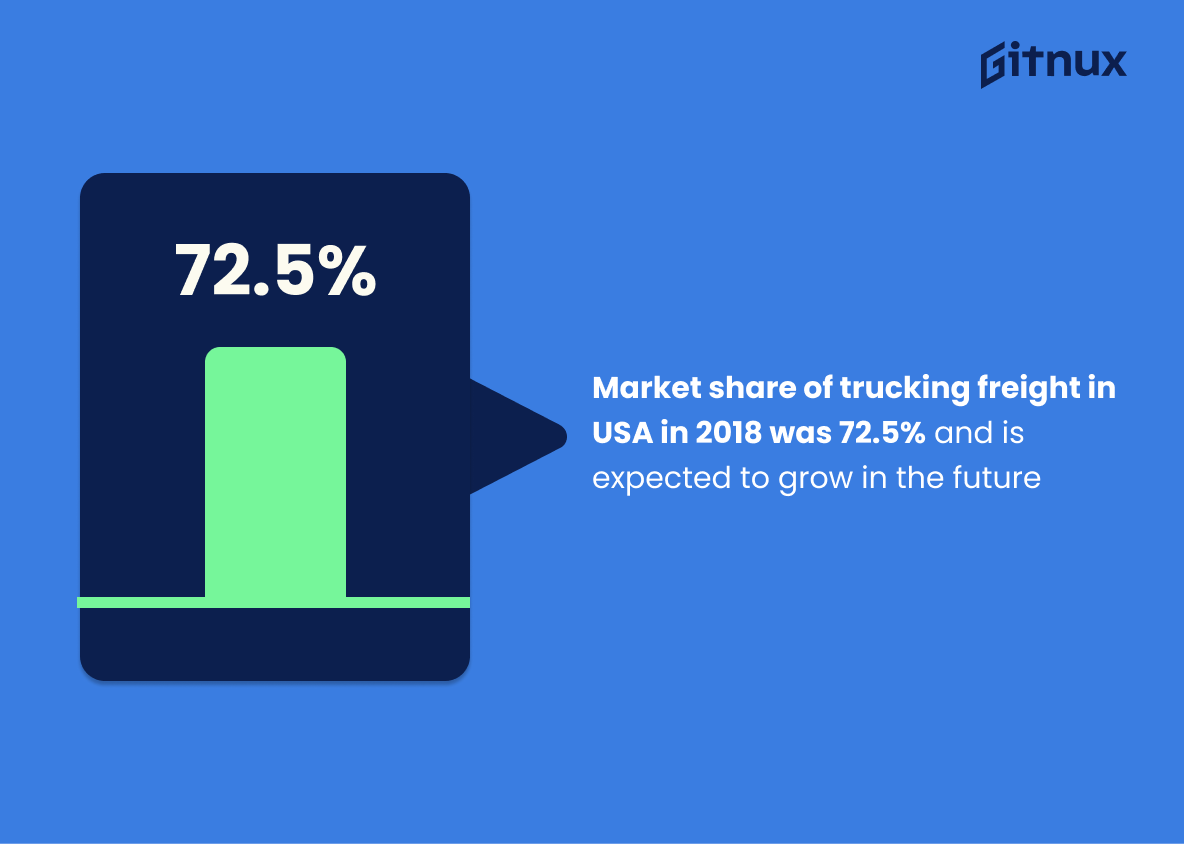Navigating the labyrinth of the logistics world, the freight brokerage industry serves a pivotal role, making it worth exploring in depth. This intriguing sector’s vitality lies in the impressive numbers it records every year, painting a compelling picture of constant growth and potential. In this blog post, we delve into the freight brokerage industry statistics, unpacking insightful data, and revealing trends that shed light on its global economic impact. Whether you’re a logistics professional, a business investor, or simply someone intrigued by this bustling industry’s numbers, sit tight. This analytical journey is set to transform your understanding and provoke thought about the freight brokerage industry’s dynamic landscape.
The Latest Freight Brokerage Industry Statistics Unveiled
The Global Freight Brokerage Market size is expected to reach $18.2 billion by 2027, rising at a market growth rate 6.6% CAGR during the forecast period.
As we sail through the sea of data around the Freight Brokerage Industry, this particular statistic serves as a vital compass guiding our analysis. In glowing terms, it pictures an industry exhibit robust potential, setting its crosshairs on a towering $18.2 billion market size by 2027. Commanding a sturdy marching pace, it’s advancing with an impressive growth rate of 6.6% CAGR. Such a scenario emboldens observers with an anchoring point – the industry is not in a state of stagnancy but is flexing its muscles for exponential growth. Interpreting this forecast can assist business projections, market positioning, and can fuel possible policy deliberations. Thus, this statistic resonates strongly, illuminating the path ahead for freight brokerage industry stakeholders with its striking forecast.
The Freight Brokerage Market in North America was valued at $4,806.3 million in 2017, and is projected to reach $5966.2 million by 2025.
The statistic paints an invigorating picture of the steady growth the North American Freight Brokerage Market is experiencing. From a value of $4,806.3 million in 2017 to an expected worth of $5966.2 million by 2025, this upward trajectory underscores the surging demand, expansion, and economic vitality within the freight brokerage industry. In ambiance of this blog post, it’s like holding a mirror to the dynamic future of the industry, equipping industry stakeholders with essential insights to navigate the marketplace and plan strategic decisions based on robust future growth.
There are 18,000 freight brokers in the U.S., but the top ten brokerages account for about 43% of the market.
Delving into these numbers, the power dynamics within the U.S. Freight Brokerage Industry are instantly brought to light. A group as small as the leading ten brokerages holds sway over a staggering 43% of the market share. This monumental figure is carved out from an expansive sea of around 18,000 freight brokers. Thus, these statistics present a starkly competitive landscape, where a handful of ‘giant’ entities dominate, leaving the rest contending for the remaining market share. This reflects the key challenge faced by smaller freight brokers – breaking into a market heavily controlled by a few heavyweights. Consequently, these numbers tell us that to thrive in this David versus Goliath landscape, innovative strategies and a differentiated service offering are crucial.
There are around 36,000 employees in the U.S Freight Brokerage Industry as of 2021.
Highlighting the statistic revolving around 36,000 employees in the U.S Freight Brokerage Industry as of 2021 weaves together a deeper narrative of the ongoing trends in the field. It paints a vivid picture of the industry’s size, reflecting its significant role in the nation’s economy. Notably, it helps draw a direct connection to the level of employment opportunities and economic impact this industry has on the U.S labor market. Lastly, it could be a key indicator for potential investors or business persons looking to understand the industry better.
In the year 2017, Freight Brokerage Market Share in LTL was over 30%.
The reveal of over 30% Freight Brokerage Market Share in LTL (Less Than Truckload) for the year 2017 paints a captivating picture of the landscape of the Freight Brokerage industry. Acting as the backbone of this entire industry, this crucial statistic illustrates the tremendous role of Freight Brokerage in the LTL market. It presents valuable insights regarding the impressive scale of operations, reflecting not only the sheer volume of freight handled but also indicating the industry’s overall economic impact.
The estimated amount of revenue generated by the brokerage and transportation sectors in the U.S in 2019 was around $80 billion.
This delightful figure of $80 billion exemplifies the robust nature of the brokerage and transportation sectors within the U.S in 2019, establishing an unparalleled economic influence. It paints a picture of a burgeoning industry, teeming with prosperous opportunities for businesses and entrepreneurs alike. By weaving this into a blog post about Freight Brokerage Industry Statistics, readers are offered an insightful birds-eye view of the industry’s financial success. Understanding this economic landmark can instill confidence in potential investors or future brokers, while also providing a benchmark for industry players to aim for in the coming years.
The freight transport management market globally which includes freight brokerage is expected to reach $41.41 billion USD by 2026.
Painting a picture of the Freight Brokerage Industry’s economic landscape, this statistic projections of it blossoming to a staggering $41.41 billion USD by 2026 serves as an anticipatory drumroll. It acts as a spotlight, illuminating the immense potential and profitability the industry boasts. As such, for potential investors, entrepreneurs, or anyone with stakes in the industry, this figure is equivalent to a navigational compass signifying prosperous horizons. Moreover, for industry insiders, it can be a launchpad for innovation and business strategy remodeling, as they prepare to surf this upward economic wave.
Asian countries are expected to exhibit a higher growth rate in the freight brokerage market due to a rise in industrialization and urbanization.
Highlighting the anticipated growth of the freight brokerage market in Asian countries paints an informative picture in a post about Freight Brokerage Industry Statistics. It spotlights a crucial geographic area where the industry should focus on, to tap into the fast-paced growth trajectory driven by ongoing industrialization and urbanization. This data point underscores the importance of recognizing global market shifts and the dynamics of economic activities across different regions, aiding freight brokers, investors, and other stakeholders to forge viable strategies and make well-informed decisions. Thus, intensifying their competitive edge and resilience within the evolving global freight brokerage landscape.
The global freight brokerage market is expected to grow at a CAGR of 4.28% during the period 2018-2022.
Delving into the whirlwind of data, an intriguing forecast catches the eye: the potent growth prediction of the global freight brokerage market. Blossoming at a Compound Annual Growth Rate (CAGR) of 4.28%, this expected acceleration from 2018 to 2022 sends us a crystal clear message about the exponential growth opportunities in this sector.
Digging deeper, this robust market growth portrayal sparks interest in potential investors, business strategists, and stakeholders, leading them to make more informed, strategic decisions. The figures spell a boatload of possibilities for start-ups, existing brokerages and graduates eyeing a career in this sector.
Furthermore, this very statistic draws a growth trajectory, helping understand how factors such as technological advancements, global trade patterns, and world economics interplay to shape the freight brokerage industry. In essence, it paints a vivid picture of the future and marks the pulse of this evolving industry, certainly making it a cornerstone for your freight brokerage blog post.
Top five companies in the freight brokerage industry account for less than 30% of the total industry revenue.
Highlighting that the top five companies in the freight brokerage industry contribute less than 30% of the total industry revenue is a tantalizing nugget of knowledge. It drives home the inherent diversity in this sector, revealing that this marketplace is not dominated by a few corporate giants, but is a vibrant ecosystem teeming with a plethora of smaller companies each clamoring for their share of the revenue pie. This scenario makes the size and breadth of the industry evident while illustrating the immense potential within the sector for new entrants to carve out a profitable niche. In essence, it embodies the quintessentially competitive spirit of the freight brokerage industry.
The freight brokerage market is expected to exceed a valuation of $58.52 billion by 2028.
Forecasting a robust valuation of $58.52 billion for the freight brokerage market by 2028 illuminates a trajectory of growth and expansion. Such intriguing forecast not only signals a flourishing industry, but also underscores the potential opportunities that lie within this sector for stakeholders, investors, and businesses alike. The roadmap painted by this statistic is an insightful compass for those navigating the labyrinth of the freight brokerage industry – directing them towards optimistic prospects. For an entrepreneur, it predicates a fertile investment ground, while for established players, it’s a clarion call for continued innovation to stay competitive in an evidently booming sector. Laced deep within these promising numbers is the assurance of job creation, economic wellbeing and industry advancement. In short, this statistic is nothing short of a wellspring of knowledge, shaping the narrative of the freight brokerage industry’s future.
The US Freight Brokerage market had registered a growth rate of 6.8% during the year 2016.
Painting a picture of the robust health of the US Freight Brokerage market, the impressive growth rate of 6.8% recorded in 2016 shines a spotlight on the industry’s vitality and notable potential. This statistic weaves a narrative of a thriving and buoyant sector, portraying not just periodic growth, but a sign of prospering momentum in the industry. Within the context of freight brokerage industry statistics, this information stands as an encouraging signpost for investors, promising opportunities and reinforcing confidence in the sector’s future. It signals strong performance in the domain and hints at the likelihood of the industry continuing this upward climb, underscoring the importance and relevancy of the freight brokerage market within the larger transportation industry.
North America will proceed to dominate the global freight brokerage market forecast period from 2020 to 2027.
Projecting North America’s sustained dominance in the global freight brokerage market until 2027 illuminates key insights crucial for understanding the terrain of the Freight Brokerage Industry. These projections underscore the robust infrastructure, organizational excellence, and technological advancements that this region possesses, which are ingredients for market leadership. These factors are instrumental in guiding stakeholders’ strategies, from competition mapping to investment decisions. Furthermore, it puts a spotlight on the transformative trends shaping the market dynamics in North America, serving as a roadmap for other regions in developing their freight brokerage businesses. Understanding this statistic is akin to having a compass in a complex industry terrain.
Market share of trucking freight in USA in 2018 was 72.5% and is expected to grow in the future.
In the vast, diverse world of freight brokerage industry statistics, this data point paints a dynamic picture of the roads ahead. The 2018 figure of a 72.5% market share for trucking freight in the USA isn’t just a mere number, it’s a proactive forecast of a highway filled with potential profits. As the market share is projected to increase, those in the freight brokerage industry should perceive this as an invitation to action. This vital information illuminates an accelerating trend of trucking freight domination, driving investment decisions, reshaping strategic planning, and reprinting the map for potential growth within the industry. Future opportunities could be navigating this lane, and for proactive individuals and companies, the road ahead could indeed be paved with success.
The average net revenue margin for freight brokers was about 16% in 2018.
Highlighting a statistic that shows ‘the average net revenue margin for freight brokers being around 16% in 2018’, underscores the level of profitability within the freight brokerage industry. Such a substantial margin paints a picture of the industry’s financial health, revealing that, on average, about 16 cents out of every dollar made in 2018 were pure profit for freight brokers. This gives readers, who might be potential investors or industry professionals, an insight into the industry’s potential for earnings. A high profit margin like this can be indicative of well-managed operations and strong pricing strategies within the industry. The statistic, in essence, adds color to the financial landscape of freight brokerage, shaping perceptions about its revenue efficiency.
The revenues from the global freight brokerage market are expected to triple in the next seven years.
“One might wonder at the sheer relevance of projecting that the revenues from the global freight brokerage market are anticipated to triple in the next seven years. Let’s uncover the truth beneath these numbers. This forecast directly indicates the vital growth potential of the industry. These numbers are not merely representative of mounting revenues, but also signal increased activity in the freight brokerage world, suggesting a boost in demand for these services. Digging deeper, the prediction ignites a broader dialogue, hinting at the global economic growth, technological advancements in the logistics sector, and potentially higher employment rates. Ultimately, this number isn’t singularly about the projected revenues, but rather a testament to the industry’s resilience, significance, and capacity for continuous transformation.”
In the last five years, the freight brokerage industry has grown by 2.7%.
This intriguing statistic notches up a noteworthy transformation in the landscape of the freight brokerage industry in the last five years. The 2.7% growth signifies a cocktail of resilience, dynamism and adaptability within this sector. It paints a picture of how freight brokerages have managed to keep their engine of growth running amidst market volatility. It is also indicative of the emerging opportunities and the promising potential for both new entrants and veterans in the industry. Indeed, this growth rate could be the catalyst of numerous analysis, forecasting and strategic planning for professionals operating in freight brokerage. So, as you navigate through this blog post, consider this growth rate as a compass guiding your understanding of the recent progress and the future possibilities within the freight brokerage industry.
Conclusion
In closing, the Freight Brokerage Industry is a vital player in the global supply chain, making it possible for businesses everywhere to operate efficiently and effectively. As the statistics reveal, the industry is projected to grow significantly in the future, driven by factors such as advancements in technology, globalization, and an increase in E-commerce. Therefore, anyone interested in starting a freight brokerage business or simply wanting to invest, now is an ideal time to step foot into this profitable sector. The key to success will be staying informed about the ever-evolving industry trends and statistics and being ready to adapt to changes and opportunities as they arise.
References
0. – https://www.www.bls.gov
1. – https://www.trioangle.com
2. – https://www.www.joc.com
3. – https://www.www.businesswire.com
4. – https://www.www.ibisworld.com
5. – https://www.www.alliedmarketresearch.com
6. – https://www.www.gminsights.com
7. – https://www.www.fortunebusinessinsights.com
8. – https://www.www.kenresearch.com
9. – https://www.www.grandviewresearch.com
10. – https://www.www.tianet.org
11. – https://www.www.fnfresearch.com
12. – https://www.www.kbvresearch.com
13. – https://www.www.ciamedical.com
14. – https://www.www.marketstudyreport.com
